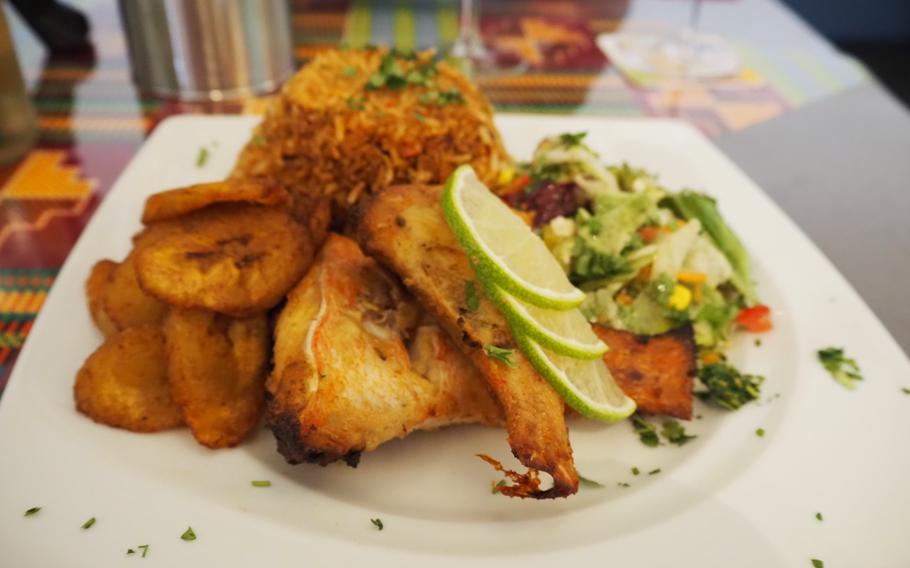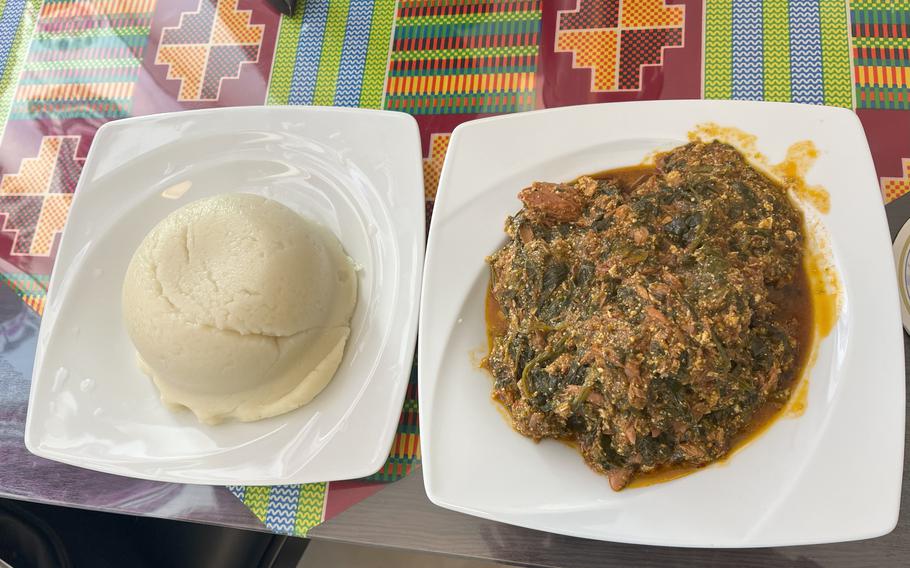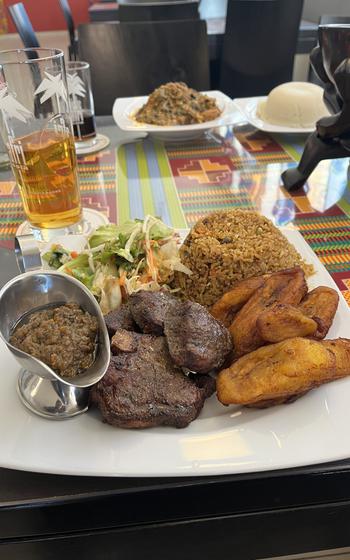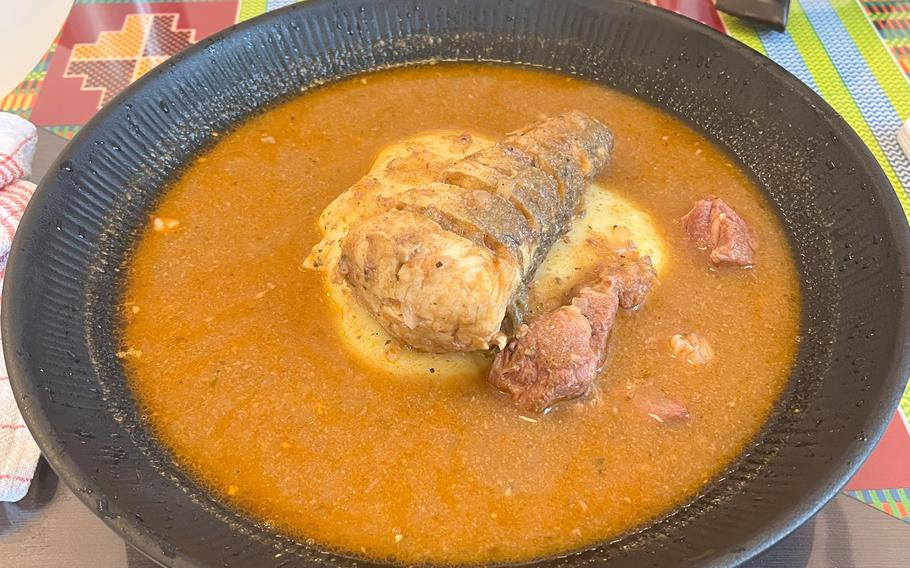
The grilled fish at Quagies in Kaiserslautern, Germany, comes with jollof rice and a side salad. Plantains can be added for 5 euros. (Chrissy Yates/Stars and Stripes)
Plenty of foods — burgers and fries, pizza, chicken wings and sandwiches — are eaten with one’s hands. But what about soup?
If you and your fingertips are up for this type of challenge, head to Restaurant Quagies Westafrikanische Küche, coincidentally sharing a building with the team handball sports club in Kaiserslautern-Dansenberg.
Some Quagies regulars include the several West African players on the current FC Kaiserslautern roster, said chef and owner Rexford “Rex” Eguakun.
Their favorite dish? “Most want fufu,” he said.
Fufu is to west African soups as injera is to Ethiopian wat, chapati flatbread is to Indian dal and tortilla chips are to salsa and guac.
It’s essentially an edible plate, although slightly tacky and stretchy instead of dry or crunchy, and it transports the delicious stewed meats and veggies into one’s mouth.

Quagies palava, a type of west African stew, served Nigerian style, meaning with fufu on the side. This presentation is the better choice for beginners because it makes the dish easier to eat. (Chrissy Yates/Stars and Stripes)
At Quagies, you can get your fufu served Ghanaian style with the stew on top or Nigerian style on the side. I’ve tried both but recommend Nigerian style for first-timers.
Somehow, years of handling hot seafood boils as a native Louisianian didn’t give my fingertips the Teflon coating needed for handling the combo of hot soup and the hot sticky starch when I tried Ghanaian-style fufu.
While I prepared for my trip by watching a few social media videos on how to roll and scoop using fufu, in the end, I made a small ball and stretched the middle into a disc that I used to pinch up pieces of the stew’s ingredients.
I later learned that, as a lefty, I committed a huge faux pas when I used my dominant hand to eat. But honestly, I’m just not ambidextrous enough to scoop hot greens or soup in my right hand and not dribble it on myself.
There are three types of soups in Ghanaian cuisine that can be served with fufu: light, peanut butter and palm nut.

The large version of the jollof rice with lamb at Restaurant Quagies Westafrikanische Küche in Kaiserslautern, Germany, comes with plantains and extra meat. If you like spicier food, request the green pepper sauce, served on the side. (Chrissy Yates/Stars and Stripes)
My first time, I tried light soup with lamb and Chilean sea bass. I preferred the fish as it did a better job of soaking up the flavor of the savory liquid.
I stripped it down to nothing but bones. I couldn’t bear to leave even a flake behind.
When I went in again to try the Quagies palaver (spinach sauce) with fufu, I decided Nigerian style was perhaps more suited to my skill set.
Also known as egusi soup in Nigeria, it’s made with cocoyam leaves in Ghana, said Eguakun, but spinach makes a delicious substitute in Germany.

Light soup with Chilean sea bass and lamb served Ghanaian style over fufu at Quagies in Kaiserslautern, Germany. (Chrissy Yates/Stars and Stripes)
The egusi is a melon seed, similar to a pumpkin seed, that gives the dish a slightly nutty flavor and creamy texture.
I skipped the lamb this time and got two sea bass fillets. It was so filling that I had to get my leftovers packaged to go. Fortunately, the stew reheated easily in the microwave, and I paired it with rice.
If you find fufu or eating with your hands a bit intimidating, just know that all of the soups/sauces can also be served with fries, baked potatoes, white rice, fried yam balls or boiled yams.
If you’re new to West African food, Eguakun recommends trying jollof rice first. This is exactly what my Midwestern American colleague tried alongside a larger serving of lamb and plantains.
My colleague mentioned he can handle a bit of spice, so Eguakun brought out green pepper sauce. It’s made with Kpakposhito pepper, which Eguakun said is common in Ghana.
He happily paired it with his lamb and even topped his plantains with it for a spicy sweet mix.
“The pain kicks in after a little bit, but it’s not unbearable,” he said between mouthfuls.
I tasted a bit of the sauce, and he’s right; it’s got a respectable heat that builds but doesn’t overpower.

The Quagies Sea, an original creation by the chef-owner, is salmon and shrimp in a cream sauce. It’s recommended to pair it with white rice. (Chrissy Yates/Stars and Stripes)
I’ve also tried the grilled fish with a side of jollof rice then the Quagies Sea, adding a serving of plantains to each. I love seafood, and the rich and flavorful sauce tasted a bit like a cream-based Louisiana etouffee.
Eguakun prides himself on his customer service and making dishes that remind people of what they’re missing from home.
“If they want something, I will (cook it) for them,” he said.
During one of our conversations about the similarities between West African and Louisiana Creole cooking, I mentioned how much I miss okra — in gumbo as well as in my grandma’s stewed okra and tomatoes.
While not typically on the menu, Eguakun said that for me, he can make okro, or okra sauce with crab and shrimp, a Ghanaian dish that bears many similarities to the gumbo I grew up with. I can’t wait to go back and give it a try.
Restaurant Quagies Westafrikanische Küche
Address: Am Handballplatz 1, Kaiserslautern, Germany
Hours: Tuesday through Saturday, 5-10 p.m.; Sunday, noon-10 p.m.; opens at noon on German holidays Prices: 15 euros to 20 euros for most entrees, 30 euros for special menu items/portions with two sides
Information: Phone: 0631-3502-7727; Online: quagies-restaurant.de